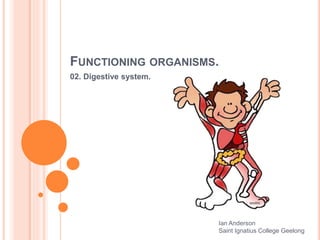
Functioning organisms - 02 Digestive system
- 1. FUNCTIONING ORGANISMS. 02. Digestive system. Ian Anderson Saint Ignatius College Geelong
- 2. KEY NUTRIENT GROUPS. The foods that we eat supply the nutrients and energy we need to carry out the important processes of life, including Cellular respiration & other metabolic reactions, Grow, Repair or replace damaged tissue, Reproduce, Move, etc.
- 3. KEY NUTRIENT GROUPS. The nutrients we require can be broken down into 5 main groups. Proteins, Carbohydrates, Fats & oils, Vitamins & minerals, Water (not really a nutrient, but essential for chemical reactions in the body).
- 4. KEY NUTRIENT GROUPS. Nutrient Role in our body Where chemically digested Proteins Growth and repair of cells. Stomach and small intestine. Carbohydrates (sugars, starch, fibre (cellulose), etc.) Main sources of energy. Mouth and small intestine. (Fibre is not digested, but assists in movement of food through digestive system) Fats & oils Stored as an energy reserve and also used for making cell membranes. Small intestine Vitamins & minerals Required in small amounts for vital cellular functions. Do not need to be broken down.
- 5. DIGESTIVE SYSTEM. Responsible for Breaking down food into smaller particles (molecules). Absorption of nutrients and water into bloodstream. Elimination of wastes. Source: http://www.cakechooser.com/
- 6. DIGESTIVE SYSTEM. Digestion. Breakdown of food into smaller particles/molecules. e.g. Proteins amino acids; Starch sugars. Two types of digestion: 1. Physical digestion = breakdown of food by physical means. Teeth. Churning of food in stomach. 2. Chemical digestion = breakdown of food by digestive juices, including enzymes and acid. Mouth – saliva contains enzymes. Stomach – gastric juices contain enzymes and acids. Small intestine – bile & pancreatic juices released into small intestine contain enzymes.
- 7. DIGESTIVE SYSTEM. Chemical digestion cont/. Most chemical reactions occurring in our body would occur too slowly to be useful without the presence of enzymes. Enzymes are biological catalysts that speed up the rate of a chemical reaction. They are not reactants in the reaction. They are not used up (consumed) during the reaction and are available to be reused over and over again. Enzymes are very specific to a particular reaction. e.g. Pepsin will only speed up the breakdown of protein; amylase will only speed up the breakdown of starch. Enzymes are very sensitive to the conditions in which they work. e.g. Pepsin will only work in an acidic environment.
- 8. DIGESTIVE SYSTEM. Absorption. Nutrients (simple sugars, amino acids, vitamins & minerals) and water are absorbed through the walls of the small & large intestines into the blood vessels of the circulatory system.
- 9. DIGESTIVE SYSTEM. Digestive system. All the organs involved with the digestion and absorption of food. Alimentary canal (digestive tract). The organs of your digestive system through which food passes during digestion. From your mouth to your anus.
- 10. Source: Cash et al. (2013) Teeth & mouth. Physical breakdown of food. Saliva contains enzymes that commence chemical breakdown of food. Enzymes are chemicals that speed up the rate of a chemical reaction. DIGESTIVE SYSTEM.
- 11. Source: Cash et al. (2013) Oesophagus. Muscular tube running from mouth to stomach that food moves through via peristalsis. Peristalsis = coordinated muscular contractions. DIGESTIVE SYSTEM.
- 12. Source: Cash et al. (2013) Stomach. Muscular ‘bag’ that squeezes and churns food with gastric juices, producing chyme. Gastric juices contain HCl & pepsin which digest protein. Stomach has a mucous lining which protects it from the acid environment. DIGESTIVE SYSTEM.
- 13. Source: Cash et al. (2013) Liver & gall bladder. Liver produces bile which is then stored in gall bladder. Bile is released into small intestine where it neutralises stomach acid & digest fats. DIGESTIVE SYSTEM.
- 14. Source: Cash et al. (2013) Pancreas. Produces pancreatic juices that are released into small intestine. Pancreatic juices contain enzymes. DIGESTIVE SYSTEM.
- 15. Source: Cash et al. (2013) Small intestine. Digestion of food continues. Absorption of most nutrients. Long length (4-6m) allows sufficient time for all the nutrients to be processed as the chyme passes through. Lining of small intestine has villi, which increases surface area available for absorption of nutrients. DIGESTIVE SYSTEM.
- 16. Source: Cash et al. (2013) Large intestine. Absorption of vitamins & remaining water. Shorter than small intestine (~1.5m). DIGESTIVE SYSTEM.
- 17. Source: Cash et al. (2013) Rectum & anus. Rectum stores any remaining undigested chyme prior to elimination as faeces through the anus. DIGESTIVE SYSTEM.
- 18. Source: Cash et al. (2013) Alimentary canal. Mouth. Oesophagus. Stomach. Small intestine. Large intestine. Rectum. Anus. DIGESTIVE SYSTEM.
- 19. DIFFERENT DIGESTIVE SYSTEMS. The digestive system of mammals are specialized according to their diet. Herbivores. Eat plant material. e.g. kangaroos, koalas, cows, etc. Carnivores. Eat meat. e.g. Tasmanian devil, quolls, tigers, lions, etc. Omnivores. Eat both plants and meat. e.g. humans, bush rat, chimpanzees.
- 20. DIFFERENT DIGESTIVE SYSTEMS. Herbivores. Plant matter is difficult to digest (breakdown). Have a long digestive tract allowing greater time for nutrients to be absorbed from digested food. Herbivores have a large caecum that contains bacteria which help breakdown the plant matter. Source: Cash et al. (2012)
- 21. DIFFERENT DIGESTIVE SYSTEMS. Carnivores. A diet high in protein. Protein is easier to digest than plant matter, so carnivores have a simple digestive system, with a long small intestine and a very small caecum (or none at all). Source: Cash et al. (2012)
- 22. DIFFERENT DIGESTIVE SYSTEMS. Omnivores. A diet made up of both plant matter and meat (protein). Will often have a long small intestine, shorter large intestine. Depending on type of diet, the caecum may be well developed. Source: Cash et al. (2012)
- 23. BIBLIOGRAPHY. Cash, S., Quinton, G., Tilley, C., & Craven, E. (2013). Oxford Big Ideas. Science 8: Australian Curriculum. Melbourne: Oxford University Press.
